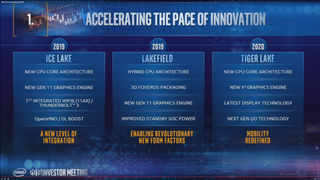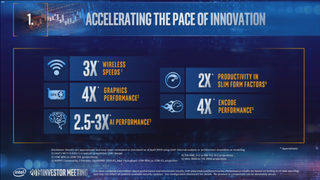Intel Announces 10nm Tiger Lake Processors to Arrive in 2020

Intel made a wide range of announcements today at its 2019 Investor Day, including the unexpectedly-quick jump to the 7nm process, but Gregory Bryant, the head of Intel's client team, made yet another announcement: Intel's new 10nm Tiger Lake processors will come to market in 2020.
This isn't entirely surprising, as these processors popped up on a recently leaked roadmap that indicated a 2020 release date. According to that information, these chips will come as four-core models that are confined to the Y- and U-Series for laptops.
Bryant said Tiger Lake has a completely new core architecture but did not elaborate. We believe these processors will come with the Willow Cove core architecture. Bryant also said the new processors could push an 8K monitor or multiple 4K displays, which comes courtesy of the Xe Graphics engine. Although Bryant did not specify, Intel's first integrated Xe Graphics will come with the Gen12 moniker.
Bryant noted that the company has working silicon running both Windows and Chrome, indicating these processors are in the final stages of development.

While technical details are slight, Bryant shared some performance data. According to Intel, Tiger Lake offers up to four times the graphics performance of Whiskey Lake processors, but it's notable that the comparison is of a 15W Whiskey Lake processor to a 25W Tiger Lake chip, meaning this is somewhat of a lopsided comparison in terms of power consumption.
Intel also claimed Tiger Lake offers twice the performance of a 5W Amber Lake processor, but again this is compared to a higher-powered 9W Tiger Lake processor.
The quadrupled encode performance bullet point is interesting, as it compares a 4K60 encode with Whiskey Lake to an 8K60 encode on Tiger Lake. Unfortunately, the test notes do not list the respective power envelopes for this test.
Stay on the Cutting Edge
Join the experts who read Tom's Hardware for the inside track on enthusiast PC tech news — and have for over 25 years. We'll send breaking news and in-depth reviews of CPUs, GPUs, AI, maker hardware and more straight to your inbox.
The "AI performance" bullet point refers to a like-for-like comparison of 15W Ice Lake and Whiskey Lake processors. The improvement in wireless speeds refers to product gains between Intel's Wi-Fi 6 and a competing 11AC chip, not the actual CPUs.

Official details are still slight, but we're told Intel will share more information shortly. We'll update as necessary.

Paul Alcorn is the Managing Editor: News and Emerging Tech for Tom's Hardware US. He also writes news and reviews on CPUs, storage, and enterprise hardware.
-
Armani316 Too bad Intel didn't discuss whether we'll see an H-series for laptops within the Tiger Lake CPU family. No word on Ice Lake-H series either. Strange.Reply -
jimmysmitty Replymdd1963 said:more laptop CPUs....
That will soon show R9-3700X who's boss! :)
The mobile market sells quite a bit. Most businesses now buy employees laptops/2-in-1s instead of desktops unless they have a need for it and the majority of consumers buy laptops over desktops. Its a pretty important market.
We don't really count. We are the small group in this world, the minority.
However I am sure they will have something to compete with Zen2 at some point. Its just that again the enthusiast market is not large enough to just cater to. -
joeblowsmynose Replymdd1963 said:more laptop CPUs....
That will soon show R9-3700X who's boss! :)
A couple possible reasons why Intel seems to be removing focus from the high end at this point:
They've had to do some things that I am sure they did not want to do (or got caught up in doing) just to try to stay ahead of Zen and Zen+ ... have you seen 8th and 9th gen power consumption? Almost double that of Ryzen in some workloads: https://www.tomshardware.com/reviews/intel-core-i9-9900k-9th-gen-cpu,5847-11.html - this is still almost a secret as if you asked almost anyone, they would tell you that AMD is hot and consumes more power than equivalent Intel processors, but in this one area Intel has had to sacrifice their very long lived efficiency trophy for clock speeds in an attempt to maintain the perception of staying ahead of AMD ... what will be next on that chopping block? Then next? It might be a lesser loss to brand image to give up the winner's trophy in this one area, and focus on gaining new or ensuring you keep the other trophies in the other areas ... one of those other areas seems to be mobile for Intel right now - there is nor doubt there is money to be had there, and AMD is putting more focus in the high end and less on mobile so competition at this end is much lighter.
The other aspect is that they are working on new designs and new nodes, and things haven't been going great. It would be much easier to work out any issues by focusing on the low power and low core parts first, then you can scale up the improvements to the larger and faster chips which would take much more time to get the improvements out of (thus more loss) than focusing on the mobile first.
By judging the way things look currently, I think Intel might just be strategically (finally) willing to not try to beat AMD in every area, but pick and choose the areas where there is least risk and most gain to be had - it appears this is mobile. Once they have that worked out, they will have invested a fair bit of time and research into power efficiency into these new designs, which they can then use to improve the higher end chips without having put up with the embarrassingly "fake" TDP number on their processors (9900k - yeah I'm looking at you!). -
Saadish i want to buy a powerful PC in winter 2020. i want intel Tiger Lake cpu with minimum 10 core and minimum 5.0Ghz base performance. if intel make late or bad again i have to buy AMD.Reply -
mdd1963 'minimum 5 GHz base'?Reply
Certainly base clock will be much lower, likely at 3.7 GHz or so to meet reasonable TDP limits.
You might get your wish for one or two cores to turbo as high as 5 or 5.1 GHz or so... as to how substantially improved this will be over the 8c/16t 9900k in gaming, this remains to be seen. (Certainly CInebench should see a roughly 20-25% hypothetical improvement with a 25% core count increase)
Most Popular



